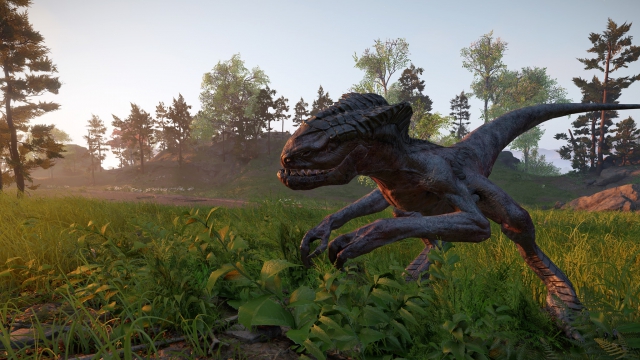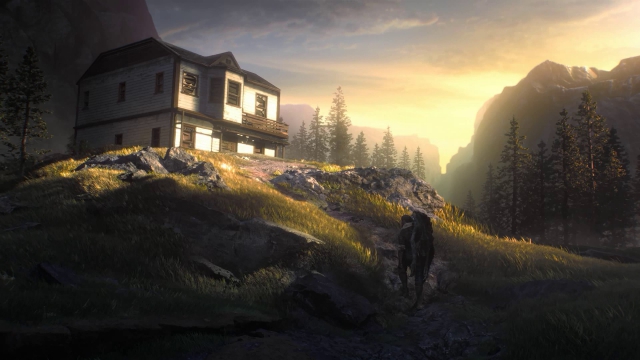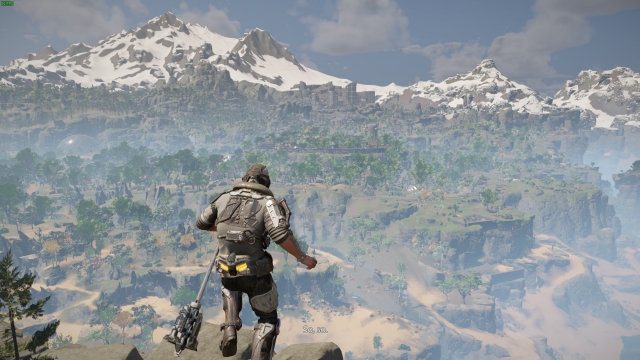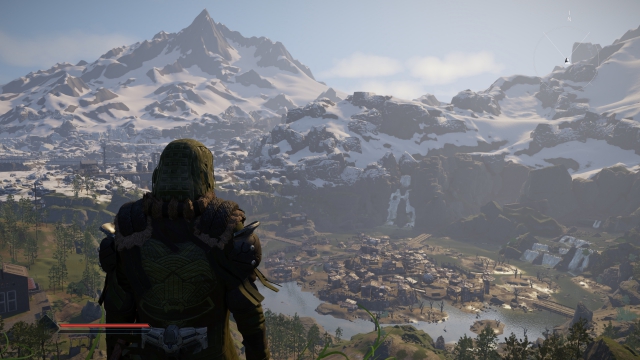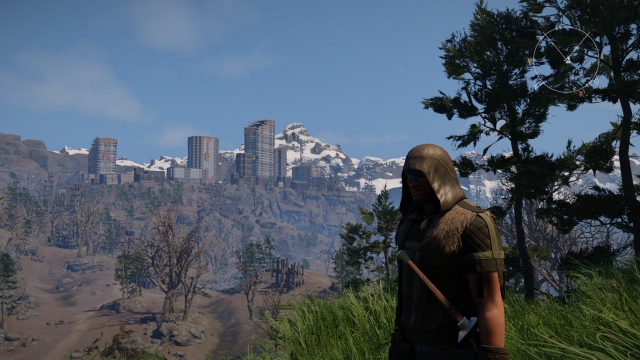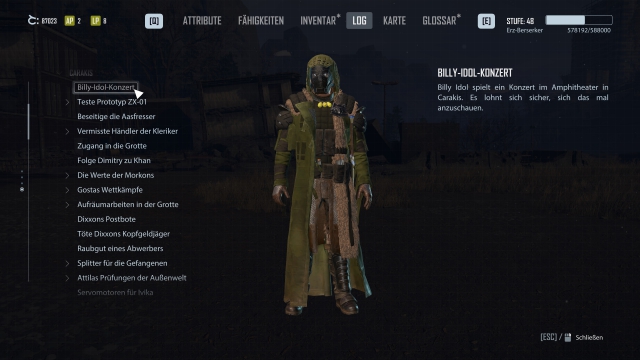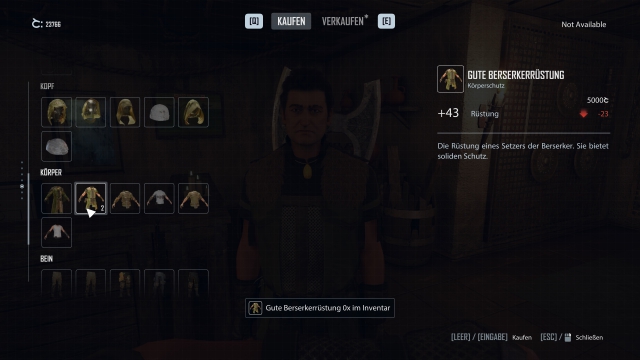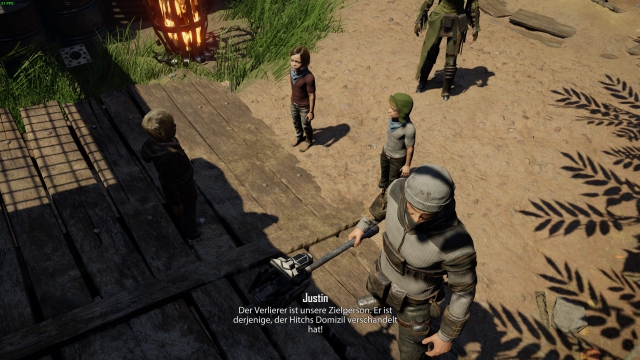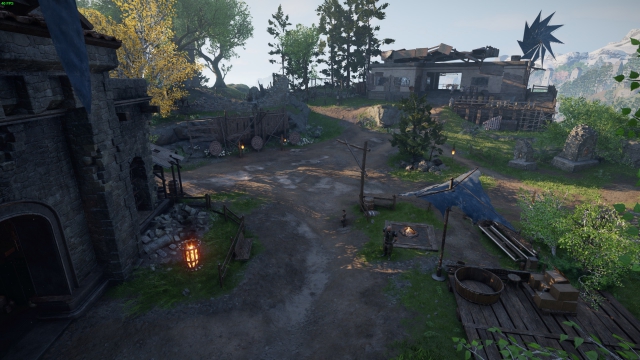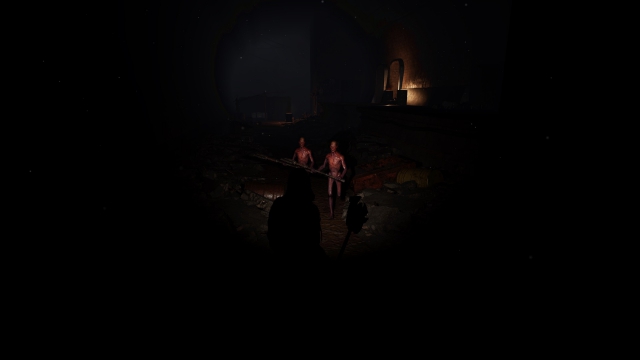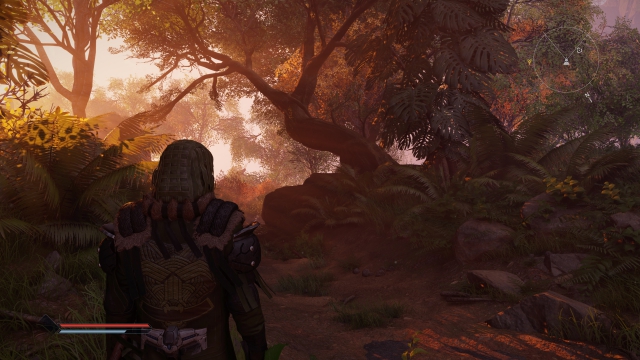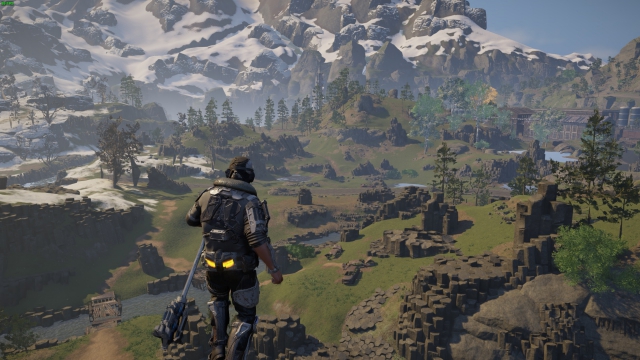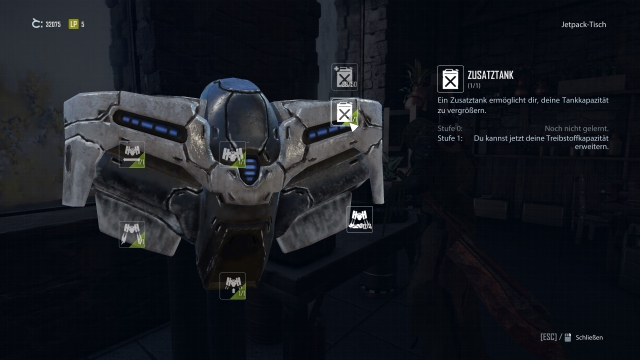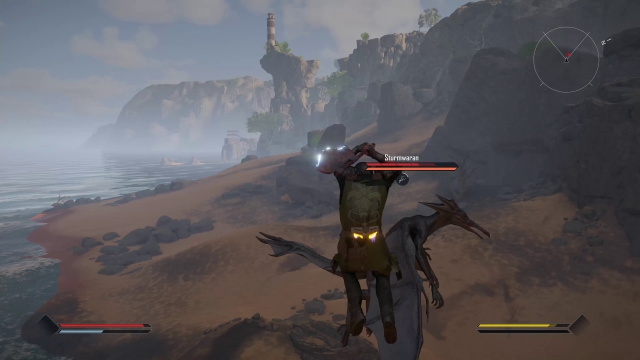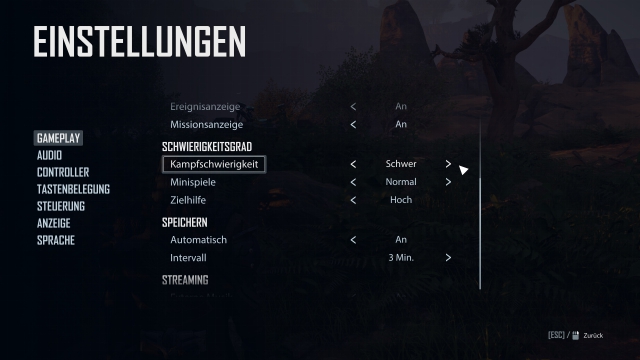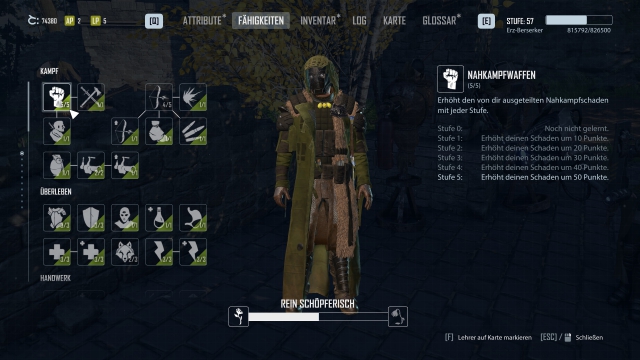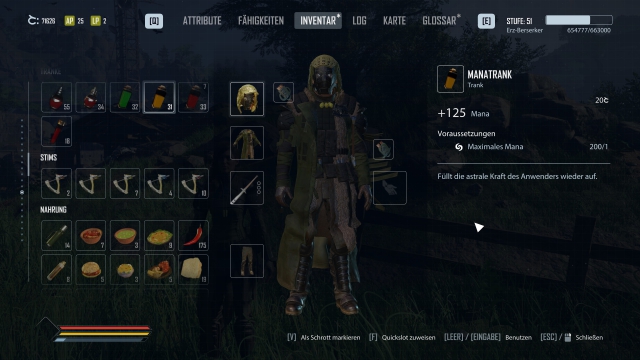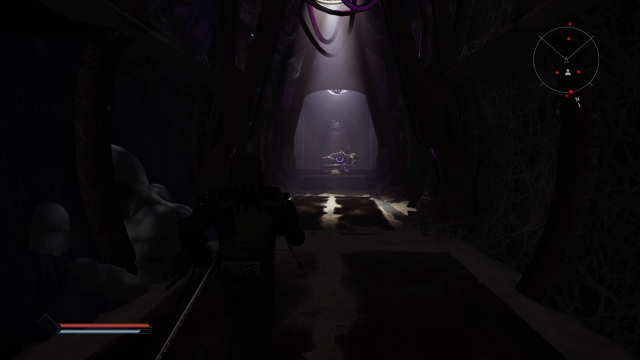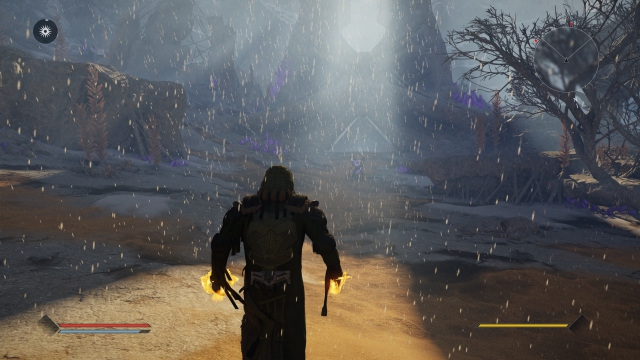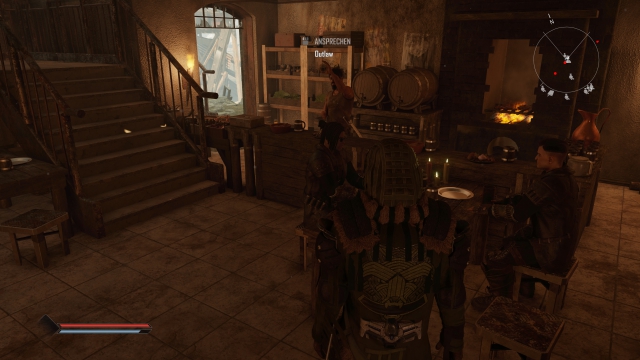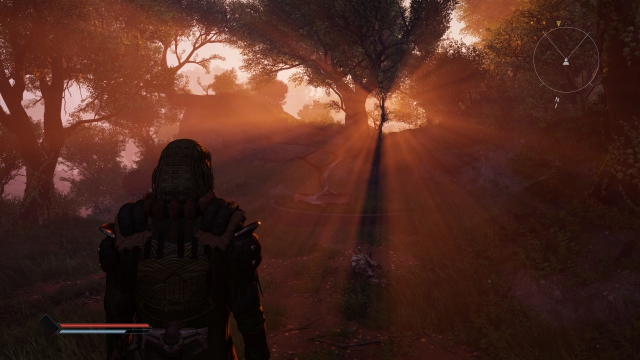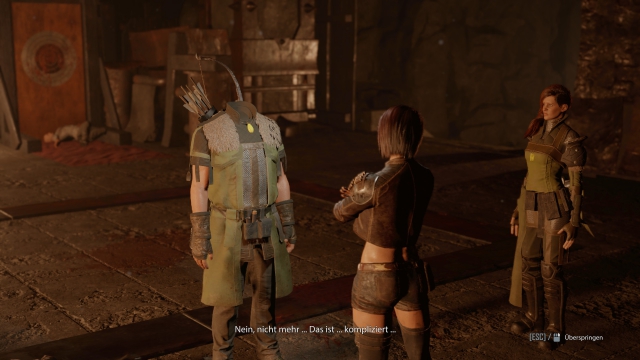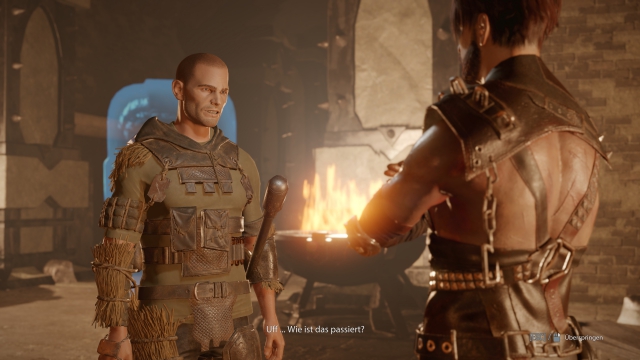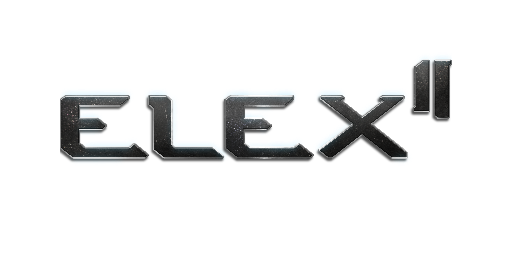
Elex 2 Review – Is the successor doing everything better?
It took a proud four and a half years for Elex 2 to finally be released. Fans have never had to wait this long for a new game from Piranha Bytes - a studio that polarizes like no other from Germany. Have the Piranhas used the long development time to improve in all aspects with Elex 2, or are the biting fish taking a bath with their ambitious vision?
By Ravenhearth and Dark Bauer
With Elex 1, the Piranhas dared to break styles in 2017 by mixing medieval fantasy and science fiction and giving the hero a name. Jax, meanwhile, lives as a hermit on a mountain after people failed to listen to his warnings about alien invaders. Elex 2 begins 6 years after the first game with the arrival of the alien Skyands on the planet Magalan, which was once populated by a modern civilization before a meteorite devastated it and brought the Elex to the world. The sudden arrival of the aliens in Elex 2 is presented in a nicely rendered intro and, of course, changes everything. The Skyands plan to reshape and subjugate the planet to their liking using a modified type of the Elex, the Dark Elex. Jax returns to the humans after the aliens destroy his hut, but is bitten by the creatures and infected with a disease on the way there in a second intro. The transition to this intro is a bit sudden, though, as the landscape shown doesn't match the in-game environment at all. One minute we're sneaking past the critters in a forested area, and the next, without warning, a video starts in which we see Jax being chased past cliffs in a desert-like region by these same beasts. Then we fall.
Piranha Bytes has chosen one of four endings for the first part. This can sometimes lead to confusion for players of Elex 1, because certain situations are forced upon you, which you didn't choose in part 1, because no savegame import was used. For example, in the predecessor we might have chosen a romance with outlaw lady Nasty - today we are in a relationship with berserker Caja and even have a son together. Piranha Bytes still manages to keep the newcomer from losing the thread, because the dialogue always offers the possibility to review what happened in part 1. However, you can't think too much about some things here either; as in all their previous games, the story isn't the most important aspect.
Left: The intros are nicely rendered
Right: The world is huge and completely open almost from the start
Jax is found by the scientist Adam and wakes up after a few days, relieved of most of his former skills. Adam's goal is quickly explained: Jax must regain his old strength and found a new faction, the so-called Sixth Power, to unite the humans and stand up to the aliens. However, this introduction could have been more gripping, as you are quickly presented with a fait accompli and released into the world without much guidance. It takes a while until interesting quests await the player. After this introduction, the player can freely decide to approach one of Magalan's now five factions to join them and win them as allies against the new threat. Let's grab the jetpack and get going.
The factions
The Berserkers, who turned their backs on technology in Elex 1 and have made it their mission to recultivate the destroyed world, are back. With the help of so-called world hearts, plants imbued with mana, they transformed wastelands into thriving forests and meadows. In Elex 2, they took over the fort in Tavar and greened the surrounding desert. Now, however, the factions aren't always the ones you remember from the predecessor. Some of the Outlaws have joined the Berserkers and changed the faction from the inside out. You can see this in the sometimes very questionable behavior of the fort's inhabitants or in dialogues and characters. Hardly anything has remained of the purely nature-loving, sincere Berserkers here. They are probably still in Goliet. There is tension between the few stiff Berserkers and the looser former Outlaws. However, those Outlaws who didn't join the Berserkers have gone to the crater of the Elex meteorite and established a new settlement there under the Outlaw Baxter.
The antagonists of the first part, the Albs, are now a playable faction. In Part 1, they consumed pure Elex, detached themselves from emotion, and thought this was the next step in human evolution. Their directive was to mine all the Elex in the world and take it by force if necessary. But the Albs and their leader, the Hybrid, lost to the free humans. Their philosophy has changed and they reject emotions only as far as they are a hindrance. But even among them there are differences of opinion as to the future direction. The Albs drove the Clerics out of Ignadon and brought their Elex with them, turning the land into an icy wasteland. The displaced clerics fled to a castle on the outskirts of Tavar and are looking to replenish their thinned ranks. They are now even smaller and continue to build their battle machines, but have not played a large role in the world of Magalan for a long time.
New, on the other hand, is the faction of the Morkons, a group of underground-dwelling Brutalos who pay homage to the god of stasis. They live in ancient caves and tunnels and ensure their survival by doing everything as they have always done. They roam Magalan and capture people to imprison and break them to join them. They perform self-flagellation, make blood sacrifices, and bind books in human leather. Some follow this word by committing suicide, for death is the ultimate standstill. This is where the dark side of Elex 2 shows itself, but some of the Morkons now reject these old ways.
Left: The Outlaws now inhabit the crater of the meteorite
Right: The game offers many beautiful views
So for the first time, there are five playable factions in a Piranha Bytes game. Jax can join these factions, or try to make his way completely without a faction, which is also a novelty. This is especially interesting for those who don't really like any of the factions, as they all have downsides, just like in Elex 1. Factionless, of course, the faction-bound abilities and armor are not available to us. As a "renegade", we have to try to make it through the world alive on our own. However, there is also a whole bunch of faction-free clothing and armor, so we have a fair chance to play the game that way as well.
It is also possible to change factions. In practice, however, the options quickly tighten up; you're not quite that free in your choice of faction. The three main factions are Berserkers, Albs and Morkons. Once you join them, you can't leave or switch to one of the other major factions. The Clerics and Outlaws are minor factions that you can only join if you already belong to a major one. As an Albs you can only join the Clerics, as a Morkon or Berserker you can join the Outlaws. The decision is made when you have made it to the second to last rank within your major faction. The player then has the choice of reaching the last rank, for example Ore Berserker, or joining the minor faction instead, remaining in his major one to work as an "informer" for the other. This also decides which armor you get access to.
Therefore, the skills of the small factions are correspondingly thin: Clerics have two new skills, Outlaws only have blueprints for stims. The skill trees of the big factions are much more extensive, so there are some spells for the Berserkers, and the Morkons have their own skills, which express the nature of the faction well. For example, with the skill "Scribe", the character inflicts damage on himself.
Also relevant for joining a faction is the new destruction value, the morale system of the game. For example, it is only possible to join the Morkons if this value is high enough. Destruction is gained by killing defenseless small animals, attacking people, or making appropriate dialogue decisions all the time. It corresponds more to the typical good/evil scheme than the cold value of the predecessor. Sometimes it is inconsistent, as the non-violent option (intimidate) is occasionally more destructive than the violent one. However, the value has much less impact in dialogues, and to our knowledge it has no influence on the end of the game. In dialogues, you can sometimes convince NPCs with appropriately high attributes.
The Quests
Since you don't have to join a faction, you can reach the second chapter of the game simply by talking to at least three factions, or by addition to joining a faction. However, if you decide to join, you have to rise in the factions' favor. For this, the game has a lot of joining quests ready, in which you help various advocates in longer quest series, which are necessary for joining. With the Berserkers, we have to get one of 3 NPCs on our side so that they put in a good word for us. Once we have done that, there is one last test to pass. Then we come to the leader and can express our wish to join the faction in front of him. Convincing the advocates is done in different ways. For Scrappy, we are supposed to go to an iron mine and see why no more iron is coming. It turns out that the mine has a problem, so it's on to designing a solution to that problem. Finally joining a faction, we have new skills available in the skill tree and new equipment available from the armorer.
Left: There are a variety of quests
Right: As a member of a faction you can buy exclusive armor
There are a few surprises and also conflicts between the factions, as well as follow-up quests. However, the quest design has regressed compared to the first game. While you could still decide many quests for one or the other faction there, with corresponding consequences, the conflict of factions in Elex 2 is rarely felt in these quests. Even something like the conflict over Abessa doesn't exist anymore. Interesting stories are a bit rarer in the second part and the world seems less rough, although this was one of Elex's great strengths. Instead, Elex 2 is more about problems within the factions, where you can make many decisions on a smaller scale. Elex 2 also contains more running tasks, but these are always embedded in meaningful stories. The cheapest fetch-quests are almost nonexistent. Unfortunately, it is often not possible to find the goal of quests without quest markers, since NPCs rarely explain the way.
The time you can spend with all of the game's accession quests and side quests, at over 30 hours, is once again equal to that of the first part. However, we recommend players not to wait so long to join a faction if they are already sure, because in our experience, quests can't expire. It is better to complete the quests throughout the game. One reason for this is that there are again no new side quests in later chapters, so then only main missions are added. In addition, there are again only a few short side quests outside of the major hubs, the majority of the other locations in the outside world are visited instead as part of main or companion quests. These companion quests are significantly longer quest series in Elex 2 that tell you more about the game's seven companions. The companions again react to the hero's deeds, so that he rises or falls in their favor. This time there is also a choice of three female partners for the romances, which are a bit more complex than in the first part.
It doesn't take much to rise in rank within a faction. A few quests and the sufficient level reached, we can move up. It doesn't really feel like doing anything big for the group and really earning the new rank. But the faction quests get more interesting later on because as you level up within factions, the aforementioned decision between main faction and side faction starts to happen.
Here and there we are also approached by people, such as children, which is another new feature of Elex 2. From them we get small, harmless tasks and stories. A nice addition that also contributes to the atmosphere and liveliness. They fit surprisingly naturally into the setting. In particular, Jax and Caja's son, Dex, plays a larger role. Parenthood is also a dominant theme in the story. However, the children's texts have the usual problem: unfortunately, they often don't come across as children. But there are series/movies where this is far more distracting. But why our son calls us "mother" and "father" and not "mom" and "dad", we can't understand. Kids also put you in moral quandaries here and there. If we are robbed by a child and later find out that he or she was sent off by an adult and is not treated very well by the adult in the process either, do we demand the money back from the child or do we let him or her keep the loot after holding the adult accountable? Kids avoid fights and hide, if we have duels among adults or with monsters. Kids also can not be attacked or killed, but this would also no longer fit Jax' character.
Left: The children integrate well into the setting
Right: The Bastion is the base of the Sixth Power
Throughout the game you gain new personnel for the bastion of the Sixth Force for the fight against the Skyands. We look for a master builder to set up the camp, a warlord to lead our warriors, comrades in arms to eventually join us in battle, and so on. The master builder can remodel Jax's premises in the style of the different factions. Apart from that, however, the bastion doesn't evolve, the somewhat ruinous appearance isn't improved despite the builder.
Game world and exploration
Speaking of the outside world: The game world of Elex 2 is, as usual from Piranha Bytes, again lovingly designed and roughly corresponds to the size of the first part. This goes against the "bigger is always better" trend that has plagued the gaming industry for quite some time. While two regions have been taken over from the predecessor and heavily modified, three regions are new. In fact, Tavar has changed so much that it's hard to recognize it unless you find hotspots like familiar factory sites or other fortifications. Even in the fort itself, orientation isn't exactly easy, and even if you still have memories of Part 1, this fort will seem like a new place in most places. In Ignadon, only a few lava rivers meander through the icy rock. This is where the Albs have set up their camp, the depot. The rest of the world of Elex 1 is no longer accessible. Abessa and Goliet are still mentioned here and there, but we can no longer visit these places. If we try to enter these areas, we are enveloped in a toxic fog, which seems very strange when you have just spoken to NPCs who report that they have just arrived from Goliet. The demarcation to the old world could have been solved more nicely. Or at least equip these NPCs with gas masks.
The new regions include the Carakis region inhabited by the Morkons (anyone else thinking of Dune?) or Maracor. However, the game world is a bit less varied, with mainly green areas, brown wasteland or snowy landscape as biomes. But the vegetation in Tavar is nicely designed, because while it becomes almost tropical in the south, it becomes more and more temperate climatically towards the north. The settlements are nicely designed and reflect the philosophies of the faction well. In particular, the crater settlement of the Outlaws looks nicely rundown.
The areas in Elex 2 are similarly extensive as in the first part, we don't notice much of a higher density in the world and quests. While roaming the large areas, we mostly find the same monsters, bandits and similar loot, such as healing potions and Elexit. Side quests are, as already mentioned, sporadic, but you'll find unique weapons of all kinds more often than in the predecessor, even early in the game, so exploration pays off quite well. You can also find audio logs and documents that reveal more about the world, but this time much less interesting from the old world. The setting is starting to show signs of wear, the world isn't as interesting as it once was, and the environmental storytelling is weaker. Again the origin of the teleporters is not addressed.
Left: Sometimes it gets really scary
Right: In Tavar it's getting downright tropical
However, there are many beautifully designed and detailed locations and natural-looking landscapes that flow smoothly into one another. The landscape is often vertical and geographically interesting and feels alive. NPCs and animals fight each other, merchant caravans move around. You can observe quite a bit, with extras scurrying around everywhere doing something. Besides the well-known small talk snippets, which the inhabitants of the camps always give to the best, you can also eavesdrop on real conversations everywhere. And find out about tasks or clues or just get an insight into people's lives. They often talk about events and meet with other people after or during quests and have conversations that you can listen to, but also ignore.
At night it is quite dark, so the flashlight comes in handy. From time to time there are even creepy moments, even underground, of which there could have been more. But some areas seem a bit too empty and bare, just like in the first part; Piranha Bytes can't design such a large game world with the same attention in every corner. And the grass looks too monotonous in Elex 2, we would have liked to see more flowers decorating the landscape, as in Elex 1. Piranha Bytes even seems to have scaled or "stretched" the areas taken over from the predecessor, so that the game world is a bit larger than a glance at the map would suggest. The reason for this was possibly the improved jetpack.
The Jetpack
The jetpack on our back (or rather on our buttocks), which we already loved in part 1, is once again our most faithful companion in Elex 2. And better than ever before. Whereas back then we could only hover for certain times, this device now allows us to swing into the air and, depending on the upgrade and tank level, fly over the world. Yes, really fly. The jetpack controls much more pleasantly than in the predecessor and roaring through the world at high speed is a lot of fun. Of course, this allows us to get to even more places, explore even more towers, cliffs or canyons than before. And it works really well, and you notice that the world was built around the jetpack. You can again reach otherwise inaccessible places like the ruins of skyscrapers, and you can also fight with flying adversaries. The jetpack can also now be upgraded, so you can unlock sideways flight and greatly increase fuel capacity to fly even longer. If we overdo it and use up our fuel in the air, Jax crashes. Compared to the predecessor, however, he can now hold onto ledges and edges on his own and climb up them or continue shimmying sideways. That doesn't sound like much, but it makes the system a lot more dynamic because we don't keep falling to the ground.
Left: With the jetpack you can fly high, but the view range is limited.
Right: The jetpack can be upgraded
The combat system
The (close) combat system hasn't been fundamentally changed, but the fights on the ground have been improved. The confrontations now seem more direct than in the first game. There are no more combos, instead Jax can perform long or short blows that can cause different damage and throw opponents off balance. Once again, the stamina bar has to be taken into account. The enemies also have this stamina bar, which lowers hit by hit. If it is at zero, they fall down and are immobile for a short time. The chance to do extra damage again without having to be afraid yourself, or to briefly knock out individual opponents in a fight against several. This sounds like an unfair situation on paper, but proves to be quite helpful and saving in the game. While human opponents always show the same attack pattern, the monsters offer more possibilities. Big monsters throw stones at you; the river creeper burrows into the ground only to reappear a few moments later in a different place; the Skyand rushers can teleport behind the player; and so on. This adds variety to the battles, even if there could have been more variance.
The character reacts faster and more directly than in the predecessor, which is good and fun - but it's still not as fast as the combat system of Risen 1. The fights are still a bit clunky, a real flow or rhythm doesn't come up. But it is a step in the right direction. One point that might piss you off is the fact that you can click dead at least the weak enemies at the beginning without them being able to defend themselves. However, this doesn't necessarily work for tougher enemies, which appear quite early on, and you have to think about which step to take. Sometimes hitboxes are inaccurate, and when many enemies come into play, it gets chaotic. When fighting, the camera zooms out a bit, but you can no longer determine the zoom of the camera yourself.
The jetpack is no help in the battle at the beginning. It only offers the possibility to quickly escape from a tricky situation, but many enemies also have a ranged attack in addition to the close-range one. And there are not only enemies that attack from the ground, no, flying monsters have also made it into the game. As soon as you have upgraded the jetpack accordingly, you can also attack from the air, which, however, is a bit awkward to control. The jetpack keeps you level and you can strike or use ranged weapons. From the air, you can also perform dive attacks, which don't always hit, but when they do, they have a correspondingly large effect. This rounds out the combat system and makes it feel dynamic, as you can react to any situation accordingly. The jetpack also allows you to safely escape any combat situation.
Nevertheless, the fights are easier to master, which is also due to the improved balancing. The game is now easier on the normal difficulty level, and the starting phase of the game is no longer so hard that you get flattened even by a chicken. However, the world also no longer seems as threatening and mysterious, and less caution is needed. It is also helpful that attributes now have a clear effect on damage, life energy, etc. again, so that you no longer run into dead ends where all quests and enemies are too difficult. In addition, you can now see all the important stats like life energy, armor and resistances. All of this together makes especially the starting phase much less frustrating than in Elex 1. The additional year of development time or polishing is noticeable to Elex 2 here. However, since you get stronger quite quickly, we recommend Gothic veterans to try it on "hard" first. This is the second highest of five difficulty levels. There are separate settings for combat and minigame difficulty.
Left: Air combat
Right: Difficulty settings
The ranged combat has also been improved, which actually works the same as in the predecessor. If we have a bow or a cannon equipped, we can aim with the pressed right mouse button and release the projectile with the left. A realistic trajectory of arrows cannot be observed. This was already a more or less small shortcoming in part 1, as far as the arrows are concerned. All in all, ranged combat now works much more precisely and less spongily, while also looking better than it did in the previous title from 2017. It now feels more rounded and satisfying, also because NPCs now show more hit reactions and weapons are easier to use. However, Elex 2 doesn't come close to real third-person shooters, which isn't absolutely necessary in a role-playing game. As expected, the Albs use ice magic. They can also drain the Elex from nemies, for example. The magic of the berserkers knows different spells, like attack spells, fire rain and protection spells and some more. However, the spells consume very little mana, so the strong magic feels very overpowered. Towards the end of the game, you can mow down even the strongest enemies in seconds on normal difficulty.
Character reactions
Most NPCs can be attacked, but neutral NPCs can no longer be killed or looted, only knocked down. While hostile NPCs such as bandits are simply blown to kingdom come, there are friendly NPCs of your own faction that cannot be attacked. If you are knocked down by an opponent and you don't happen to be in an official duel, you will die as well. A knockdown like in Gothic does not take place. Here only reloading helps. Companions help you, sometimes more, sometimes less, in the fight. They stay out of the mentioned duels. The inhabitants of Magalan again have a daily rhythm and react as usual to monsters, sneaking, stealing, drawing weapons, fighting or entering unauthorized areas. If you get caught and escape, there is a penalty. Pickpocketing, lock picking and hacking work as in the predecessor, there are no other mini-games. Through them, you often get valuable items.
Character progression
If you explore a lot, you'll find a lot of items and become rich at some point. Especially through the animal trophy skills you can earn a lot of money. In addition, you can find Elex in many places, which you can process into Elex potions that can give you learning and attribute points. Used correctly, you don't have to specialize at all in the end and can learn practically anything. Also, you can now sip the potions completely without drawbacks. Additionally, there are attribute potions, but you don't have to save them up, since their effect counts as a bonus and they don't increase the cost of attribute increases. Basically, the character system isn't very complex, but it is very motivating, as all attributes and skills are useful and thus you are faced with exciting decisions for most of the game. For each level up we get ten attribute points (AP) and one learning point (LP). We can invest the AP directly in the menu in different categories. If we have visited a teacher and invested enough AP, we can learn a skill, which then consumes LP (and Elexit). It is sometimes a bit opaque, which skills a teacher teaches exactly. Because not every survival teacher can teach you all skills of this category. It is a pity that skills are again not explained by teachers and you only "buy" them from them.
Left: Jax of all trades - with enough Elex potions you can learn almost anything
Right: The inventory has been improved
Crafting and Interface
At various workbenches we can prove our skills in different crafts. Brand new here is the jetpack workbench, where we can really upgrade our jetpack this time. Whether that's brake jets that protect against fall damage, extra tanks for more range, etc. Here you can tinker with something that will prove exceedingly useful in movement, exploration and combat. Besides brewing potions, weapons can be made from three damaged ones, you can craft ammunition, use stones and cook dishes. There are separate workbenches for this again in Elex 2, the universal workbench is history. The damaged weapons do less damage, but also need lower prerequisites than their mint types. Also, you can now see the hero working in the background while crafting, so there is animation again. Ingredients and blueprints for crafting can be found through exploration or at merchants.
The interface for crafting has been reworked in Elex 2 and now looks tidier. The inventory is also much clearer and the abstract symbols have given way to icons that show the actual appearance of the items. Items attached to the character are clearly visible. A new feature is the glossary, which lists NPCs and monsters that have already been encountered as the game progresses, including a description. If you stay in the menu, the game continues to run in the background. The movement of the hero is sometimes a bit sluggish/spongy. Especially when you want to look around for items in buildings, the ex-commander often makes one step or turn too much.
The Story
Once you have explored the world, quested and decided on a faction (or not), the main storyline continues the fight against the Skyands. At first, however, it seems rather unfocused and you are given various tasks that are often unrelated. The staging also leaves a lot to be desired here; if a camp is "attacked" by enemies, they just stand around in a field nearby without the leaders of the camps even commenting on it. Furthermore, the threat of the Skyands isn't completely noticeable, because they don't spread over Magalan apart from missions and stay in their territories until the end. Thus, the threat doesn't really seem dramatic. The enemies that repopulate the world during chapter changes and the constant respawns are therefore animals and monsters. As in the first part, the placement of enemies seems a bit jumbled; weak and strong enemies can be found all over the world. As usual, you have to come back stronger if you are not yet a match for the enemies. There is a clear sense of progression.
Towards the middle of the story, however, it becomes more interesting and begins to raise intriguing questions. At the beginning, the aliens are just "evil aliens", which is a less exciting starting point than in the predecessor, which raised interesting questions from the start and offered a more interesting antagonist in the form of the Albs. Nevertheless, you always want to know what happens next, and fortunately the story isn't quite as predictable as it seems at the beginning. Now, only later does a bit more complexity develop, even though many main quests consist of killing enemies. Meanwhile, Jax's illness causes him to have seizures, during which he wakes up in other places without memory and which get on your nerves over time. Later, you'll also enter dungeons, which are nicely designed and differ in layout, but offer little variety in terms of gameplay. You fight your way through them, but there are no puzzles or interesting loot.
Left: The dungeons are nicely designed
Right: The Skyands remain profileless for a long time
However, the story can't always answer the raised questions satisfactorily in the later course and often degenerates to a to-do list without big surprises. Only in the last part of the game does the story become more dramatic, but in terms of gameplay, it almost only consists of killing off hordes of enemies. In addition, the later story twists are abstruse or unsatisfying and the game ends with a disappointing boss fight and ending, after which you are allowed to continue playing and talk to your allies. After the end of Elex 1, we had higher hopes for the sequel. It took us about 60 hours to complete the main storyline and all the side quests, but we haven't explored every nook and cranny.
Presentation and graphics
The story is told in significantly more in-game cutscenes, which are also better done than in the first part, since the characters don't mostly stiffly face each other. This is reserved for the dialogue, in which people are incomprehensibly mostly static opposite each other and rarely move an arm or the head, and in which the camera switches back and forth as usual. Sometimes there are flashbacks from the first Elex as videos to make new players understand the backstory. However, these videos are somewhat pixelated, and even a concert that is much advertised in the game is only a cutscene. This was already better solved in Gothic 1. The NPCs show less pronounced gestures, but have improved lip synchronicity. Apart from that, the faces are somewhat emotionless, even in the cutscenes.
The graphics of Elex 2 have made visible progress in direct comparison with the predecessor: the whole graphic style looks more realistic, textures are sharper, models are more detailed. Especially in interiors, the additional details on furniture and small objects are noticeable. Also, some NPCs look more lifelike, their skin has more details, hair and beards look much better and shine realistically. The faces had opened a big barrel after the preview material, but have been greatly improved. However, some figures still look slightly waxy and the grass flickers. In addition, the range of vision is limited, in the distance the game quickly lacks details. Some status effects, like the one during poisoning, are ugly. However, Elex 2 convinces with pretty lighting and volumetric effects, dense vegetation in some places and pretty water. The fog is not permanently as strong and dense as in the predecessor. Unfortunately, the current in rivers once again doesn't affect the hero.
Left: The interiors and characters appear detailedt
Right: Lighting and vegetation are impressive
However, the improved graphics take a big toll on performance: on our test machine, performance roughly halved compared to the first game. We had expected a certain reduction in FPS, but in our opinion the drop is out of proportion to the rather moderately improved graphics. It's not entirely obvious where the performance disappears to, because Elex 2 is by no means graphical reference. As expected, it does not come close to the prettiest games of the last generation, such as Horizon Zero Dawn or Red Dead Redemption 2, overall in terms of details and technology, which is fine. Nevertheless, Elex 2 makes equally high or higher demands on the graphics card than these games.
Those who now think that the game at least spares the processor are mistaken. While nature was less of a problem for the processor, performance plummeted in the five large settlements. Particularly when walking around, there were sometimes jerks and drops to or below 30fps, on a system that meets the recommended requirements. In addition, we had visual bugs in the cities on all systems, where all sorts of objects popped away and back up quickly while moving, resulting in some real "fireworks" in places. The architecture builds up or reloads again and again, models are exchanged, sometimes the level disappears for fractions of a second and reappears the next moment. This also happened in dialogues, so that characters sometimes missed their head, body or hair. Herer you can find a short video that demonstrates the problem in the worst case. The engine seems to be overwhelmed with the additional details and the numerous objects and NPCs in the cities, despite the latest game version. Although these glitches did not directly affect the gameplay, they destroyed the immersion in places. We hope that Piranha Bytes will get these problems under control, we don't know how common they are though.
Links: Don't lose your head - sometimes there are visual bugs
Right: Our reaction to it
Apart from that, Elex 2 is relatively bug-free. In contrast to the predecessor, the AI already worked well at release, apart from occasional glitches. Sometimes glitches occurred, but crashes were rare. However, we had a plot stopper shortly before the end, which made completing the story impossible. Apparently we got two quests in the wrong order. However, loading an earlier save game and completing the other quest first got around the problem.
Voice acting and sound
Of course, nothing happens in the world without dialogs. The dialogs are again written in great detail, but don't always get out of hand like the ones from the predecessor. The voice actors dub the dialogs skillfully for the most part. The conversations almost always seem as if the voice actors were actually standing opposite each other. Not only in dialogues between the hero and NPCs, but also between two or more NPCs. The companions in arms often throw in their own comments, which also vary depending on the companion, so there's a lot of variation. Also, the companion characters comment quite often on the environment, in different ways.
The music is on the level of the predecessor and still more or less casually underscores the scenery, but here and there nice and more memorable melodies can be heard. It underpins the adventures with suitable sounds most of the time without being distracting. The much criticized sound effects are hardly improved and still weak, almost giving the whole game a second-rate touch. Even the well-known "garbage can sound" is still in the game.
Ravenhearth's opinion: It's not easy for me to rate Elex 2. The game didn't become the hoped-for leap, but it's not a flop either. It does a few things better than its predecessor (jetpack, combat system, balancing, graphics, presentation) and retains some of its strengths (level design, scope, factions, companions). However, Elex 2 also disappoints with content regressions (story, quest design, world), making the game more of a sideways step. It's no Gothic 2, but it's no Risen 2 either. Those who liked Elex will probably like Elex 2, and those who were put off by Elex's inaccessible sides might like it too - especially when Piranha Bytes gets the technical problems under control.
Dark Bauer's opinion: I said at the time about Elex 1 that Piranha Bytes had built a good foundation with it. I still stand by that today, but unfortunately they didn't get past the first floor with Elex 2, where so much more would have been possible. For that, as you can read in the text, there are too many "buts" in places where potential was lost. They've improved a lot of things: combat system, character system, jetpack, graphics (excluding the no-gos like reloading objects and bodies, of course)... The techniques behind the game have all been modernized and improved. Flying is so much fun that I, who doesn't really like running around and uses fast travel systems where they exist, hardly wanted to use the teleporters. The quests themselves, which (too) often ultimately end in combat, are also fun and mostly don't feel like work. Unfortunately, not that much has changed on the content level, in some ways the predecessor was even better.
All in all, I'm sorry to say that while Elex 2 is definitely a lot of fun and does a lot of things better compared to its predecessor, Elex 1 remains the more well-rounded game in the end. Crashes, graphics errors or possible plot stoppers can really spoil the gameplay experience. Despite the already long development time, half a year longer certainly wouldn't have hurt. Perhaps Corona has also contributed to this. Nevertheless, I'm looking forward to part 3, and for those who left part 1 behind because of the unfinished level system, the high difficulty or the spongy controls in combat and in the air, Elex 2 is definitely worth a try. For everyone else too.
| Pros | Cons |
| + Nice CGI Intros | - Abrupt transition |
| + Less frustrating start... | - ...but also less interesting |
| + Science Fantasy Setting... | - ... that wears out |
| + Improved Cutscenes | - Disappointing story |
| + Continue playing after the end | - Disappointing finale |
| + Atmosphere | - Visual Bugs |
| + Children fit in well | - Talking too much like adults |
| + Good Quests | - Fewer big decisions |
| + Many Quests | - No new side quests after the first chapter |
| + Nicely written dialogues | - Presented statically |
| + 50 to 70 hours playing time | - |
| + Huge open world... | - ...which is less varied |
| + Old and new regions | - |
| + Good level design, urge to explore | - World a bit too vast and empty |
| + Dungeons | - No puzzles |
| + Improved Jetpack, Flight | - Clunky air combat |
| + Five settlements | - |
| + A bastion of your own... | - ...which can hardly be expanded |
| + NPCs that feel alive | - that cannot be killed or looted |
| + More direct combat system | - Still too janky |
| + Magic... | - ...whis is too strong |
| + Better Balancing | - Too many Elex potions |
| + Motivating character system | - Teachers don't explain skills |
| + Lockpicking, hacking, pickpocketing | - (Otherwise no minigames) |
| + Understandable moral system... | - ...that has little effect |
| + 3 main, 2 additional factions | - Secondary factions with few skills |
| + Faction quests... | - ...that are sometimes too simple |
| + Crafting with animation... | - ...in the background |
| + Companion quests... | - ...which become repetitive |
| + Romances | - |
| + Improved Interface | - A little sterile |
| + Easy controls | - Slightly sluggish, automatic camera zoom |
| + Professional voice actors | - |
| + Atmospheric music | - Little memorable |
| + Radio music | - Poor sound effects |
| + Improved graphics | - Performance issues, crashes |
| + Very good lip sync | - Some faces, stiff facial expressions |
| + Current in water... | - ...which has no effect |
| + Glossary | - Fewer interesting documents |
Links









